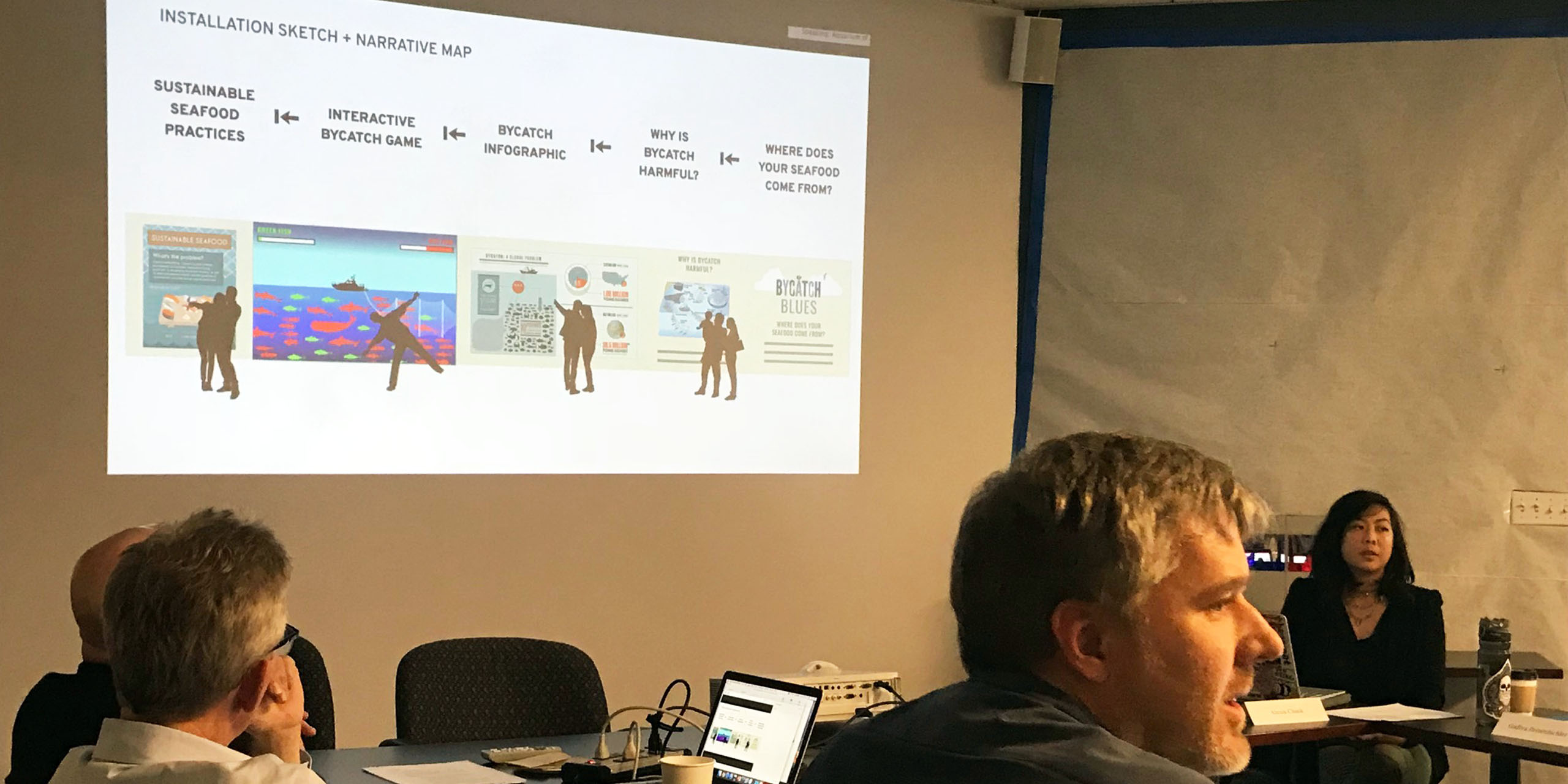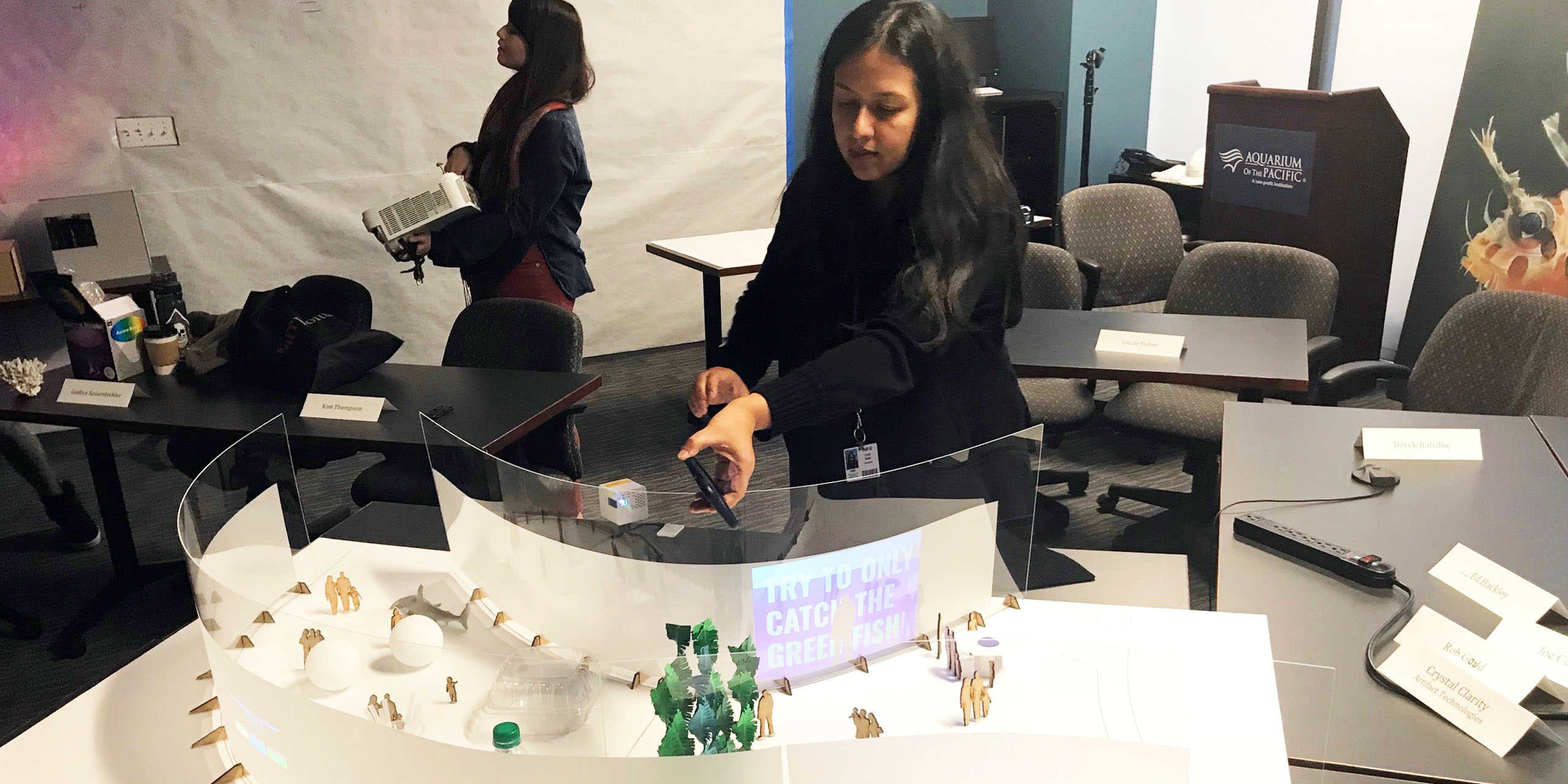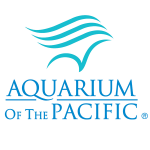A Future Vision for the Aquarium of the Pacific
- Sustainable Development

Written by Brenda Rees
Packard Fellowship invited ArtCenter students, faculty to develop concepts for new wing at Aquarium of the Pacific, Pacific Visions.
In the first part of 2019, the Long Beach Aquarium of the Pacific will unveil Pacific Visions, an impressive addition to its seaside campus. This $53 million, two-story, 29,000 sq. ft. wing will display innovative, state-of-the-art educational and artistic platforms to communicate the challenges and opportunities of the world’s oceans – and it will also feature two exhibits conceptualized by a pair of ArtCenter students and a faculty member.
The students – Alexia Chuck (undergraduate Graphic Design) and Godiva Reisenbichler (graduate Media Design Practices) – joined Interaction Design instructor Todd Masilko for a semester-long Spring Fellowship project sponsored by the David and Lucile Packard Foundation, who have been big supporters of the Aquarium’s educational work.
The Pacific Vision Fellowship trio was tasked with ideating and fleshing out two exhibit concepts that would find a home in either the educational or art gallery spaces within the new Pacific Vision wing. As creative consultants on the project, the trio researched, developed and honed ideas which were ultimately handed over to museum vendors to bring those concepts into reality.
“We’ve taken care of this baby for so long and it was a little hard to hand it over,” admits Chuck. “We all plan to be there on opening day to see how our concepts will be actualized. It will be so exciting!”

Informed Brainstorming Strategy
Overall, there were two halves to the Fellowship, explained Masilko. “Phase One was to generate ideas based on topics previously explored in earlier Designmatters studios and look at them in the context of the expansion campaign. The goal was to come up with between 15-20 ideas to present to the Aquarium.”
Knowing that brainstorming in a vacuum is neither productive nor fun, the team reached out to Doug McCauley, Assistant Professor of Ecology, Evolution and Marine Biology at UC Santa Barbara, who authored an influential article in the 2015 Science Magazine “Marine Defaunation: Animal Loss in the Global Ocean” about the science behind the current state of the world’s oceans. That article became an important resource for the Fellowship team. McCauley had given an overview to ArtCenter students in the previous Blue Hope Designmatters studio, and invited the Fellowship trio to spend a day with him and his team in the laboratories. That meeting proved invaluable.
The Fellowship team visited scientists who are actively monitoring and studying ocean acidification and sustainable fishing among others relevant topics. “Being able to talk to these passionate and knowledgeable scientists, you just feed off that energy and excitement,” said Chuck. “You realize that this is their lives’ work and how fortunate it is for them to work right next to the ocean. They are super-connected with that world.”
“One thing that struck me was when Doug said, ‘You designers are the people who make science matter to people,’” remarked Reisenbichler. “It’s exciting to know that design can be an intermediary for science and communicating it well to the public. People could read science articles online, but do the concepts sink in? Design is another way to ask, ‘Did this stick with you? Do you understand what’s at stake?’”
Indeed, the stakes became higher after that first meeting said Reisenbichler. “We realized that the work we would do matters on a bigger level.”
Armed and inspired with overwhelming information, the team developed individual ideas, sharing thoughts and feedback via weekly face-to-face meetings on the ArtCenter campus and through Skype, Google Hangout and other platforms.
“The main challenge for us was not to sugarcoat the situations, but focus on the idea of empowerment,” continued Chuck. “Presenting the facts – maybe in a distilled way – that is still the truth, but putting those concepts alongside the ways that people can participate with real world solutions according to the experts – that was our goal.”
Each team member refined and honed their own concepts but also assisted others with creating table top models, mini-projections, mock-ups and other tangible presentation boards.
In late February, the trio presented their concepts to the Aquarium staff and members of their outside creative consulting firms that create exhibit designs for museums across the country. “It was like an ArtCenter final!” exclaimed Masilko about the detailed and high-energy presentation.
While the Aquarium raved about all of the concepts, they ultimately selected two to move forward: one a physical installation and the other a digital interactive piece – exhibits that will balance out other elements that are currently planned in Pacific Visions.

Two Concept Focus
While they had worked independently on their own concepts, the trio now re-focused their energies into two concepts as a team: an art installation, Infinity Coral, and a digital game, Bycatch Blues (current working titles). Each project merited another field trip.
Inspired by Yayoi Kasama’s Infinity Room currently on display at the Broad Museum in downtown Los Angeles, the team’s Infinity Coral idea also taps into the power of mirrors to present a vision of underwater coral life. The team spent a day at the Broad exhibit documenting and observing audience engagement with the art installation, especially the “Selfie Trap” or “Instagram-able Moment” habits.
“We loved the fact that [the installation] is very simple – mirrors, lights and colors – but it creates such a surprising visual environment,” explained Masilko. “Not only are people captivated by it, but they want to be photographed with it – which is just exactly what we want to happen with our installation.”
The team had to consider crowd management and families with kids who may be more anxious to see the animal exhibits than a piece of art. The final Infinity Coral proposal employed a series of little openings, multiple “portholes of discovery,” arranged at various heights – which can be artistically-pleasing and practical since they help avoid audience clogging.
The poignancy of ocean acidification is introduced in the installation design of the two possible futures. One scenario depicts a lush colorful coral habitat while another portrays coral as bleached and dying. The underlying message: this is happening right now and the choice is ours.
The other project, Bycatch Blues, was inspired by the trio’s original trip to Santa Barbara where they learned about the unintended consequences of fishing for one type of creature and catching another in the process, i.e. the bycatch. To refine and zero in on the important elements essential for this interactive digital game, another trip to UCSB was needed for additional insights and feedback.
“In the second visit we got a lot of information that we had to condense into a few main points and translate it in a way that the public can understand,” explained Chuck about all the complex elements involved in the bycatch issue – fishing methods, technologies, individual country policies, etc.
The digital game, structured for quick play to keep audiences moving, needed engagement and a relatable science message hook. The team ultimately created an experience where players would select a type of seafood to eat – namely salmon, tuna, pollock or shrimp. Through gesture control technology and projections, players would experience the gear and equipment needed as they would physically “catch” their meal using full body movements. More importantly, they would learn the bycatch and fishing habits associated with their choices and could comparing how alternative selections could lessen the impact on marine ecology. A timer would signal a player’s turn is over. The whole experience is planned to clock under 90 seconds.
“We wanted people to understand that their choice matters,” summed up Masilko who added that, for him, the fact-finding trips to UCSB were highlights of the Fellowship experience. “I really believe in the opportunity for art and design to work with science collaboration. And that goes both ways: for us to learn from them, and for them to see how we work, see the creative components. It was eye-opening for them as well.”
Chuck agreed, adding that “Balancing the concept and the message; what we learned scientifically and what the public would be able and willing to understand. That was a huge bridge to create. But it was fun! That is the designer’s job: to create a bridge between heavy information.”
Looking back, all three members of this small but effective team complement each other well – and all took the work seriously. “The strength of our concepts showed that we weren’t pulling ideas out of assumptions, we were pulling them out of actual facts,” said Chuck. “The three of us represented three different disciplines and we all learned something from each other in the process,” added Reisenbichler. “I feel really lucky to have worked with these two fantastic talents.”
After the final presentations in early June, the Fellowship trio handed over their conceptual work, documentation and files to the Aquarium’s contracted design and fabrication firms that are now working to actualize those exhibits for next year.
When Pacific Visions is completed, the Aquarium estimates that it will be able to serve 2 million visitors each year, increasing their capacity by 25 percent. Through their experience at the Aquarium, each visitor represents the possibility of transformational behavior and attitudes that could be invaluable on a global level.
“Like it or not, the future of the planet is going to be determined by people,” said Masilko. “If we ignore it, we are still determining its future. Or if we do the best possible job we can, we are determining the future. You can’t hide it. The future is really up to us.”

